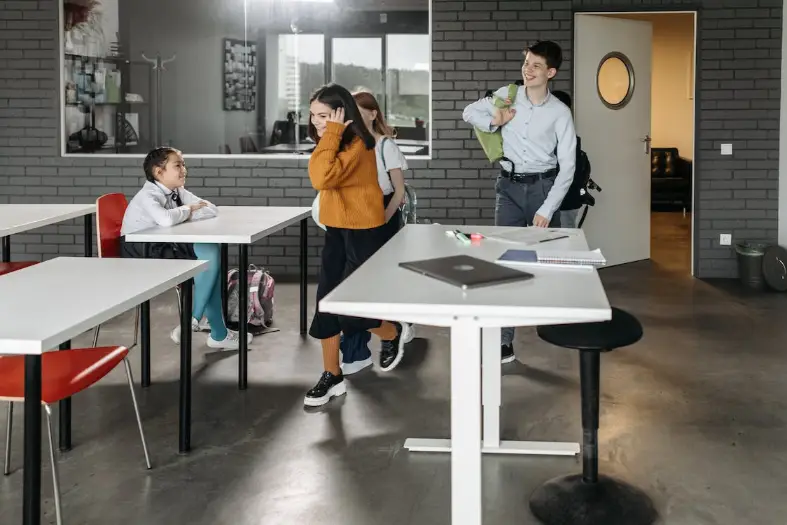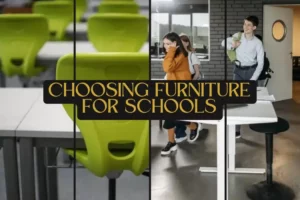Furniture in a school environment goes beyond just a physical necessity – it plays a crucial role in shaping the learning space, influencing comfort, concentration, and even the health of students. The right furniture can enhance classroom dynamics, facilitate effective learning, and encourage engagement. With an array of options available in the market today, choosing the right furniture might seem daunting, but by focusing on key factors such as functionality, durability, and ergonomics, this task can become manageable and even enjoyable. This document aims to guide you through the essential considerations when choosing furniture for schools, to help create an optimal learning environment for every student.
Age-appropriate furniture

For example, primary school students will need smaller desks and chairs, while high school students will need larger, more robust furniture. Age-appropriate furniture promotes proper posture, which contributes to better concentration and comfort. It also ensures safety, as oversized or undersized furniture can cause accidents and injuries.
Children aged 6-12 are considered to be in the developmental stage of middle childhood, where they are growing rapidly and building motor skills. On the other hand, teenagers aged 13-18 are in the adolescent stage, where their bodies are changing, and they have different physical needs. By choosing furniture that caters to the specific age group using it, schools can provide a safe and comfortable learning environment for students.
Subject-specific furniture
Science labs may require sturdy tables and chairs that are resistant to chemicals. Art rooms might need easels or tables that are easy to clean. Getting science stools for classrooms that are in need of lab equipment and furniture, for example, can provide students with the necessary support while conducting experiments. Different subject-specific furniture can also contribute to a more engaging learning experience by providing practical and functional tools for students.
A great example would be using standing desks in classrooms, promoting a more active learning experience for students and reducing sedentary behavior. However, it’s essential to strike a balance and not overlook the basic ergonomic needs of students while choosing subject-specific furniture.
Special needs furniture
If your school caters to students with special needs, consider furniture that is accommodating to their needs. For instance, wheelchair-accessible desks or chairs with added back support can make a huge difference. Schools should also consider furniture that is adaptable and adjustable, allowing students with physical disabilities to use them comfortably. It’s crucial to create an inclusive learning environment for all students, and providing them with appropriate furniture can contribute significantly to their learning experience.
What is most important is to consult with your school’s special education department and get their input on the specific furniture needs for students with disabilities. Many manufacturers offer specialized furniture for special needs, making it easier for schools to cater to their diverse student population.
Comfort
Ergonomic designs that support good posture can greatly enhance the learning experience. Students spend a significant amount of time sitting at desks, so it’s important to choose furniture that is comfortable and promotes good posture. Adjustable chairs and desks can accommodate students of different heights, ensuring proper alignment and reducing strain on the body. Additionally, choosing soft seating options such as beanbags or cushions in reading corners or common areas can provide students with a cozy space to relax and recharge. Should you opt for leather seating for this case?
Well, that will greatly depend on your situation, as leather is usually quite expensive and requires extensive care. Comfortable furniture can also contribute to a positive learning environment, as students are more likely to be engaged and focused when they feel at ease. Of course, comfort should never come at the cost of functionality and durability.
Durability

Consider materials that are sturdy, easy to maintain, and have a long lifespan. Furniture in schools is subject to heavy use, so it’s important to choose materials that can withstand wear and tear. Wooden furniture is a popular choice as it is durable and easy to repair if damaged. Similarly, metal or plastic furniture may be more suitable for high-traffic areas such as cafeterias or outdoor spaces. Investing in quality furniture not only ensures longevity but also saves costs in the long run. Children are very rough with furniture, so it’s essential to choose materials that are resistant to spills, scratches, and stains.
In fact, around ages 6-11, children are in the stage of “concrete operations,” where they understand cause and effect. This means that they may purposely damage furniture during this stage, making durability an important factor to consider when choosing school furniture.
Versatility
Furniture that is adaptable and flexible can be beneficial, particularly for classrooms that are used for multiple purposes. For example, a classroom may need to be used for lectures, group work, or presentations. Having furniture that can easily be arranged and reconfigured to suit different activities can enhance the functionality of the space. This not only maximizes the use of resources but also promotes flexibility in teaching methods and encourages collaboration among students.
Additionally, versatile furniture can also cater to changing needs or class sizes, providing schools with more flexibility in managing their space. Many kids will spend six or more hours a day in school, so it’s essential to provide them with a learning environment that can adapt to their needs. Most importantly, versatile furniture can help create spaces that foster creativity, interaction, and learning.
Aesthetics
A well-designed, attractive learning environment can stimulate creativity and motivation. Choosing furniture in vibrant colors or patterns can add a touch of fun and playfulness to the space, particularly for younger students. Additionally, coordinating furniture with the overall design and theme of the school can create a cohesive and inviting atmosphere. The aesthetics of furniture also play a role in creating an impression on visitors, such as parents or potential students, highlighting the school’s dedication to providing a high-quality learning environment. By considering the aesthetics of furniture, schools can create a space that is visually appealing and conducive to learning.
Choosing the right furniture for schools requires thoughtful consideration of various factors such as age-appropriateness, subject-specific needs, special needs accommodations, comfort, durability, versatility, and aesthetics. By keeping these considerations in mind, schools can create a conducive and engaging learning environment for students. It’s also important to involve teachers and students in the decision-making process, as they are the ones who will be using the furniture daily. By working together, school administrators, teachers, and students can ensure that the furniture chosen meets their specific needs and contributes to a positive learning experience for all. Investing in quality, functional, and adaptable furniture is an investment in the future of education.
